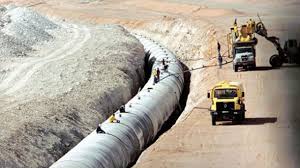Known for its arid climate and water scarcity, one North African state, Libya, has pinned its hopes on an impressive network of pipes and reservoirs to meet its irrigation needs. The Great Man-Made River (GMMR) is a monumental infrastructure project spanning the length of Libya.
With an estimated budget of $25 billion, it channels high-quality freshwater from ancient aquifers beneath theSahara Desertto Libya’s coastal regions, where the majority of its citizens live.
The giant project remains a vital source of water for Libya’s population, though it has run into numerous hurdles in recent years.
What Really Is the Great Man-Made River?
The Great Man-Made River is a vast irrigation and water supply project, designed to transport fresh water from the Nubian Sandstone Aquifer system in the Sahara Desert to the Libyan coast for domestic, agricultural and industrial use.
The discovery of this system in the 1950s coincided with the discovery of the country’s oil reserves and, following the rise to power of Gaddafi regime’s in the 1969, developing these into a reliable source of water for Libya’s largest cities became an attractive alternative to the country’s overexploited coastal aquifers and the expensive process of desalination.
According to the Great Man-Made River Authority (GMMRA), awarded the construction contract for the project in 1983, the importance of the GMMR is “of a crucial and strategic nature,” given that it could prove “the sole solution to the drinking, irrigation, and industrial water shortage problem at the Libyan state.”
Given its scale, the project was dubbed the “eighth wonder of the world” by Libya’s late leader Muammar Gaddafi, and this title is not without justification.
The GMMRA estimates that around five million tons of cement have been used to make the pipes, that the raw materials used could build “20 Great Pyramids of Giza,” and that the steel wires used in the manufacturing of the pipes are “long enough to circle the earth 280 times.”
With a pipe network stretching around 1,750 miles, according to the GMMRA, it is designed to transport around 6.5 million meters cubed of fresh underground water per day once at full capacity.
Challenges Facing the Great Man Made River Project
Since water was first transported by the GMMR in 1989, the project has played a vital role in providing water for Libya’s more populous coastal regions, which previously suffered from extreme water scarcity.
However, the GMMR has also encountered a number of hurdles that have prevented it from reaching its full potential.
When the Libyan uprising began in early 2011, around 70 percent of the project was completed.
During the ensuing civil war between Gaddafi’s forces and Western-backed rebels, a water-pipe factory in Brega, which manufactured cylinder pipes for the GMMR, was destroyed by a NATO airstrike under the pretext that it was a “military storage” facility for the government forces.
At the time, one of the project’s leaders, Abdel-Hakim el-Shwehdy, said that this would prove “a major setback” for the future of the GMMR.
Impact of the Civil war on the Project
As a result of the civil war and the subsequent instability that has since wracked the country, many of the GMMR’s existing sections have fallen into disrepair, and the project has been stalled at the third of its four stages. By 2019, 101 of 479 wells on the western pipeline system had been dismantled.
Malak Altaeb who is a Paris-based researcher and former non-resident fellow at the Tahrir Institute for Middle East Policy, and spoke about the GMMR.
Altaeb stated that, while the war itself interrupted bigger parts of the GMMR project, the change in Libya’s leadership that occurred in the year 2011 has also exacted a toll on its overall subsequent development.
“The Great Man-made River Project is a mega project that, I believe, solely relied on the former regime politically to sustain both its presence and functionalities,” Altaeb said. “It received a lot of support from Gaddafi’s regime in terms of both financial flow and security to the construction and networks.”
She also added that the precarious security situation that has plagued Libya since the year 2011 has prevented foreign companies from consulting on or contributing to the GMMR’s project completion.
The future of Libya’s Water Supply
Far from Gaddafi’s dream of turning the Libya’s desert “as green as the flag of the Libyan Jamahiriya,” the GMMR has exposed the precariousness of the country’s water supply in the face of ongoing political upheaval.
According to the Atlantic Council, “the absence of a comprehensive water policy or plan have placed Libya under significant water stress, potentially jeopardizing its ability to supply water to its people.”
Altaeb revealed that water shortages have become a “new reality” for Libyans today, and that the problems faced by the GMMR have alerted the country of the need for alternative sources to meet its water needs.
“I think that there is a realization that alternative water resources are essential to meet the growing demand and ensure water security for people as the risk is higher to only rely on this project,” Altaeb said, adding that even the groundwater from the Nubian aquifers is itself a non-renewable commodity.
Project Fact Sheet
Project cost: $25 billion
Location: Libya
Capacity: 2.5 million cubic meters of water daily
Contractors: Libyan government, Brown & Root and Price Brothers, Dong Ah, and Al Nah
Significance: Water supply
Construction commencement: 1984
Completion of construction: not determined
Size: 1,752 miles
Also read: World’s Largest Iron Steel Plant to be Constructed in Benghazi, Libya
Saipem Awarded Sub-Sea Intervention Services Contract for Libya-Italy pipeline

